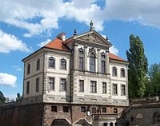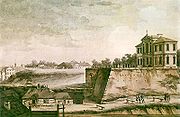
Ostrogski Palace
Encyclopedia
Ostrogski Palace, or Ostrogski Castle , is a mansion in the city center
of Warsaw
, on ulica Tamka
.
Begun by the powerful Ostrogski
family who gave their name to the building, it currently houses the Fryderyk Chopin Society and Fryderyk Chopin Museum
.
escarpment directly below the Nowy Świat, was bought by Prince Janusz Ostrogski
in early 17th century. As the area had been still a suburb of Warsaw and exempted from the laws of the city which prevented the inhabitants from building private fortifications, Ostrogski decided to build a small castle there. For that he financed a bastion
on which the manor was to be constructed. However, it was not until after his death that the manor itself was started. Designed by Tylman of Gameren, the palace built on top of the bastion was to become one of the wings of a huge future palace. However, it was never completed and was bought by deputy chancellor of the crown Jan Gniński, who turned it into his seat.
 In 1725 the palace was bought by yet another magnate family, the Zamoyski
In 1725 the palace was bought by yet another magnate family, the Zamoyski
, who made it a seat of their jurydyka
. However, as the unfinished manor lacked many features of an 18th century magnate palace, it never served its original purpose and with time became neglected. Since 1778 it was divided onto small flats and started serving as a hostel for students, owned by Marcin Nikuta. Converted into a military hospital by the French in 1806, between 1812 and 1817 it was abandoned and gradually fell into disrepair. During the November Uprising
it was bought by the Polish government and refurbished to become a military hospital once again. Turned over to civilian authorities in 1836, it continued to be a hospital until 1859, when it was bought by the Musical Institute. It was there that both Stanisław Moniuszko
and Ignacy Jan Paderewski
received their education. In late 19th century an additional story was added and in 1913 a new, much larger seat for the Institute was built adjacent to the palace.
Destroyed by the Germans in the effect of the Warsaw Uprising
of 1944, the building had been rebuilt by Mieczysław Kuzma between 1949 and 1954, while the ruins of the 1913 construction were demolished. Since then it houses the Fryderyk Chopin Society.
at the Fryderyk Chopin Society in Warsaw was established in the 1930s. At that time, thirteen valuable manuscripts were purchased from Ludwika Ciechomska, granddaughter of Ludwika Jędrzejewicz, Chopin's sister, and Bogusław Kraszewski. The creation of a Collection of Photographs, Recordings and a Library was started prior to 1939.
In 1945, the Fryderyk Chopin Institute opened again in Warsaw, and was housed at first in Zgoda Street and from 1953 in Ostrogski Castle. This was also the home of the Museum, Library and Collections of Photographs and Recordings. The museum covers the history and works Chopin, including original manuscripts and documents written by the composer, photographs and sculptures of him, letters, as well as hosting piano recitals and competitions of Chopin's works. The rich plafonds, stucco and Pompeian style
fresco
es are a fitting setting for the rooms of the Fryderyk Chopin Museum.
Warszawa-Sródmiescie
Śródmieście is the central borough of the city of Warsaw. The best known neighborhoods in the borough are the Old Town and New Town ....
of Warsaw
Warsaw
Warsaw is the capital and largest city of Poland. It is located on the Vistula River, roughly from the Baltic Sea and from the Carpathian Mountains. Its population in 2010 was estimated at 1,716,855 residents with a greater metropolitan area of 2,631,902 residents, making Warsaw the 10th most...
, on ulica Tamka
Tamka
Tamka, or ulica Tamka, is a street in the Powiśle district of Warsaw, Poland. The street runs downhill from central Warsaw toward the Vistula River and connects ulica Świętokrzyska with the Wisłostrada....
.
Begun by the powerful Ostrogski
Ostrogski
Ostrogski was one of the greatest Ruthenian princely families of the Grand Duchy of Lithuania.They were most likely of Rurikid stock and descended from Sviatopolk II of Kiev. Some scholars however claim their descent from Galicia-Volhynia line of Rurikid dynasty. Vasilko Romanovich Prince of...
family who gave their name to the building, it currently houses the Fryderyk Chopin Society and Fryderyk Chopin Museum
Fryderyk Chopin Museum
Muzeum Fryderyka Chopina is a museum in Warsaw, Poland dedicated to the great composer Fryderyk Chopin. It was established in 1954.Birthplace of Fryderyk Chopin in Żelazowa Wola is one of its major departments.-History:...
.
History
The spot for the palace, a large lot of land on the VistulaVistula
The Vistula is the longest and the most important river in Poland, at 1,047 km in length. The watershed area of the Vistula is , of which lies within Poland ....
escarpment directly below the Nowy Świat, was bought by Prince Janusz Ostrogski
Janusz Ostrogski
Prince Janusz Ostrogski was a Polish-Lithuanian noble.Janusz Ostrog - statesman of the Commonwealth...
in early 17th century. As the area had been still a suburb of Warsaw and exempted from the laws of the city which prevented the inhabitants from building private fortifications, Ostrogski decided to build a small castle there. For that he financed a bastion
Bastion
A bastion, or a bulwark, is a structure projecting outward from the main enclosure of a fortification, situated in both corners of a straight wall , facilitating active defence against assaulting troops...
on which the manor was to be constructed. However, it was not until after his death that the manor itself was started. Designed by Tylman of Gameren, the palace built on top of the bastion was to become one of the wings of a huge future palace. However, it was never completed and was bought by deputy chancellor of the crown Jan Gniński, who turned it into his seat.

Zamoyski
Zamojski, plural: Zamojscy is the surname of an important Polish nobility family of Jelita coat of arms. The name is sometimes spelled Zamoyski. It is the Polish for "de Zamość" - the name they originally wore as lords of the place...
, who made it a seat of their jurydyka
Jurydyka
Jurydyka is a generic Polish term for a settlement right outside a royal city, that was independent from the municipal laws and rulers but instead remained under the jurisdiction of the ecclesiastic or secular lord who chartered, founded and owned it...
. However, as the unfinished manor lacked many features of an 18th century magnate palace, it never served its original purpose and with time became neglected. Since 1778 it was divided onto small flats and started serving as a hostel for students, owned by Marcin Nikuta. Converted into a military hospital by the French in 1806, between 1812 and 1817 it was abandoned and gradually fell into disrepair. During the November Uprising
November Uprising
The November Uprising , Polish–Russian War 1830–31 also known as the Cadet Revolution, was an armed rebellion in the heartland of partitioned Poland against the Russian Empire. The uprising began on 29 November 1830 in Warsaw when the young Polish officers from the local Army of the Congress...
it was bought by the Polish government and refurbished to become a military hospital once again. Turned over to civilian authorities in 1836, it continued to be a hospital until 1859, when it was bought by the Musical Institute. It was there that both Stanisław Moniuszko
Stanisław Moniuszko
Stanisław Moniuszko was a Polish composer, conductor and teacher. His output includes many songs and operas, and his musical style is filled with patriotic folk themes of the peoples of the former Polish-Lithuanian Commonwealth...
and Ignacy Jan Paderewski
Ignacy Jan Paderewski
Ignacy Jan Paderewski GBE was a Polish pianist, composer, diplomat, politician, and the second Prime Minister of the Republic of Poland.-Biography:...
received their education. In late 19th century an additional story was added and in 1913 a new, much larger seat for the Institute was built adjacent to the palace.
Destroyed by the Germans in the effect of the Warsaw Uprising
Warsaw Uprising
The Warsaw Uprising was a major World War II operation by the Polish resistance Home Army , to liberate Warsaw from Nazi Germany. The rebellion was timed to coincide with the Soviet Union's Red Army approaching the eastern suburbs of the city and the retreat of German forces...
of 1944, the building had been rebuilt by Mieczysław Kuzma between 1949 and 1954, while the ruins of the 1913 construction were demolished. Since then it houses the Fryderyk Chopin Society.
Chopin Museum
The Fryderyk Chopin MuseumFryderyk Chopin Museum
Muzeum Fryderyka Chopina is a museum in Warsaw, Poland dedicated to the great composer Fryderyk Chopin. It was established in 1954.Birthplace of Fryderyk Chopin in Żelazowa Wola is one of its major departments.-History:...
at the Fryderyk Chopin Society in Warsaw was established in the 1930s. At that time, thirteen valuable manuscripts were purchased from Ludwika Ciechomska, granddaughter of Ludwika Jędrzejewicz, Chopin's sister, and Bogusław Kraszewski. The creation of a Collection of Photographs, Recordings and a Library was started prior to 1939.
In 1945, the Fryderyk Chopin Institute opened again in Warsaw, and was housed at first in Zgoda Street and from 1953 in Ostrogski Castle. This was also the home of the Museum, Library and Collections of Photographs and Recordings. The museum covers the history and works Chopin, including original manuscripts and documents written by the composer, photographs and sculptures of him, letters, as well as hosting piano recitals and competitions of Chopin's works. The rich plafonds, stucco and Pompeian style
Pompeian Styles
The Pompeian Styles are four periods which are distinguished in ancient Roman mural painting. They were originally delineated and described by the German archaeologist August Mau, 1840 – 1909, from the excavation of wall paintings at Pompeii, which is one of the largest group of surviving examples...
fresco
Fresco
Fresco is any of several related mural painting types, executed on plaster on walls or ceilings. The word fresco comes from the Greek word affresca which derives from the Latin word for "fresh". Frescoes first developed in the ancient world and continued to be popular through the Renaissance...
es are a fitting setting for the rooms of the Fryderyk Chopin Museum.
Trivia
- The cellars below the bastion are supposedly home to a Golden DuckZłota KaczkaZłota Kaczka is a Polish award presented by the monthly Film since 1956.- Złota Kaczka for best movie :* 1956: Sprawa pilota Maresza* 1957: Kanał* 1958: Popiół i diament* 1959: Pociąg* 1960: Krzyżacy...
, a mythical creature from one of Warsaw's legendLegendA legend is a narrative of human actions that are perceived both by teller and listeners to take place within human history and to possess certain qualities that give the tale verisimilitude...
s.
External links
- National Chopin Institute, the current owner of the palace
- Modern and pre-war pictures

